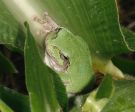Cope’s Gray Treefrog: Hyla chrysoscelis (Cope, 1880), Gray Treefrog: Hyla versicolor (LeConte, 1825)
Comment: Hylachrysoscelis and H. versicolor are distinguishable only by chromosome number (H. chrysoscelis is diploid, H. versicolor is tetraploid) and mating call (trill rate is faster in H. chrysoscelis).


Key Characters: Large toe pads; pale spot under eye; orange or golden yellow patches in groin and inner thigh.
Similar Species: Bird-voiced treefrog and Green Treefrog, but neither have orange patches on the groin and inner thighs. See Key to Frogs & Toads of Illinois for help with identification.
Subspecies: None recognized.


Description: Medium-sized (up to 6 cm SVL) brown or greenish brown frog with a black star-shaped or irregular X-shaped blotch on back. Belly pale, throat of male dark. Dark bars on arms and legs. Pustule under joint of outer finger of hand usually not divided. Recently transformed juvenile is bright green. Individuals may change color from light gray to lime green depending on temperature and background.
Habitat: Trunks and branches of trees. Adults mate in woodland pools, roadside ditches, and other temporary bodies of water.
Natural History: Diet consists of small insects and spiders. Feeding adults and juveniles are often attracted to house lights and windows where insects accumulate. Breeds late April to August. Breeding call is a guttural trill resembling Red-bellied Woodpecker song. Eggs, laid in packets attached to vegetation at water’s surface, hatch in a few days and tadpoles transform in about two months. Bold red-orange and black tadpole tail provides easy identification.
Distribution Notes: Documenting the distribution of the two species of gray treefrogs requires analysis of call recordings or chromosome counts and is therefore quite difficult.
Status: Common to very common throughout Illinois.
Etymology: Hyla – (Greek) in honor of Hylas, a companion of Hercules; chrysoscelis – chryso (Greek) meaning gold; kelis (Greek) meaning spot, stain; versicolor – versi (Latin) meaning various and color (Latin) meaning color.
Original Description: chrysoscelis: Cope, E.D.1880. On the zoological position of Texas. Bulletin of the US National Museum. Vol. 17 51 pp.; versicolor: LeConte, J. E. 1825. Remarks on the American species of the genera Hyla and Rana. Annals of the Lyceum of Natural History of New-York 1: 278-282.
Type Specimen: chrysoscelis: not designated, neotype TNHC 37293; versicolor: not designated, neotype AMNH 84483.
Type Locality: chrysoscelis: “near Dallas”, neotype is “2 miles west of the Colorado River on Highway 969, Bastrop County, Texas”; versicolor: “Northern States”, neotype is “Alpine, Bergen County, New Jersey”
Original Name: chrysoscelis: Hyla femoralis chrysoscelis; versicolor: Hyla versicolor
Nomenclatural History: In addition to the fact that the relationship between chrysoscelis and versicolor wasn’t discovered until 1966 (Johnson, C. 1966. Species recognition in the Hyla versicolor complex. Texas Journal of Science 18: 361–364), Cope named a subspecies of versicolor, H. v. phaeocrypta (Cope, E. D. 1889. Batrachia of North America. Bulletin of the United States National Museum 34: 5–525) from a specimen from Mt. Carmel, Illinois. Later authors considered phaeocrypta to be a full species, but it was finally sunk into versicolor by Viosca (Viosca, P., Jr. 1928. A new species of Hyla from Louisiana. Proceedings of the Biological Society of Washington 41: 89–91) and Smith (Smith, P. W. 1953. A reconsideration of the status of Hyla phaeocrypta. Herpetologica 9:169–173).


